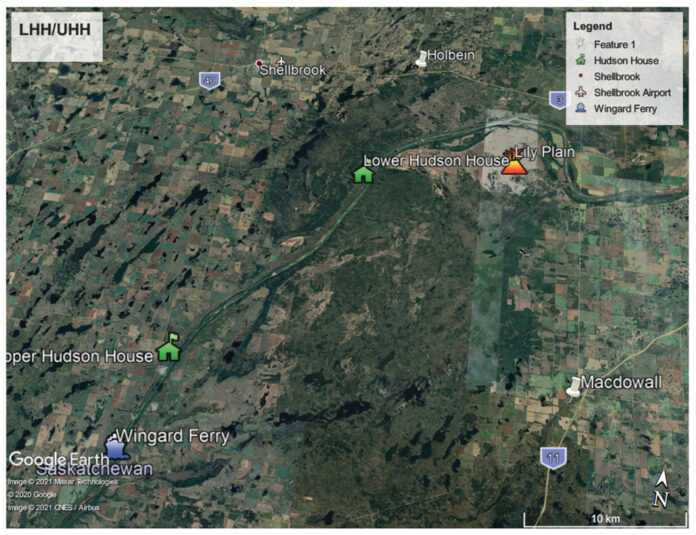
A pair local history buffs are seeking Prince Albert city council’s support for their campaign to have Lower Hudson House designated as a provincial historic site.
The house was one of several fur trading posts built by the Hudson Bay Company along the North Saskatchewan River to compete with North West Company Traders. It was abandoned in 1787, roughly a decade after it was built, then burned to the ground by rivals in 1791.
The site was lost until archeologists rediscovered it in 1929, but has remained unoccupied expect for a few expeditions and excavations by Saskatchewan researchers. Now, local historians Peter Burns and Philip Parr are looking to bring more attention to the house and its history by having it designated a provincial historic site.
Burns said Monday’s presentation to city council is a stepping stone on the road to getting the provincial government’s approval.
“They (the government) wants to make sure they’re not choosing a site on insignificance, and also, they want to make sure there are no objections or concerns of any kind,” Burns said during an interview on Friday. “We thought that if we’re putting an application forward that we should be in touch with all the local governments to make sure there’s not any real concerns…. It also creates an interest and an awareness.”
Burns has taken several trips to the site, which sits on the north side of the North Saskatchewan River in the RM of Shellbrook. He became interested in it after finding piles of buffalo bones and old tools during his trips to the area.
Burns said it took a while for the significance of the findings to sink in, but once he started investigating the history of the house, he realized it could help fill several important gaps in the area’s history. He also realized other local residents who asking the same question he was: why isn’t this already considered a historic site?
“That site, for just the decade that it existed, was (part of) just an amazing transition,” he explained. “We thought, ‘that deserves greater recognition,’ so it kind of energized us after finding the bones.”
Lower Hudson House was a hub of economic activity in the region for the first several years it operated. Post journals record Assiniboine, Cree, A’Aninin, Piegan, Blood and Blackfoot traders all journeyed to the fort to exchange furs.
However, that activity halted in 1781, when a smallpox epidemic swept into the area and decimated First Nations traders and communities. At the time, doctors estimated up to 95 per cent of local the Indigenous population died in the epidemic, while those who survived often starved. Company journals say 24 Indigenous people were buried at the site during the pandemic, and Burns says that makes the area a de facto burial ground.
Hudson Bay company forts were required to keep journals recording day-to-day activity. The journal shows company representatives understood Europeans were generally immune to the epidemic, as well as the importance of isolation and disinfection in treating victims. In their letter to council, Burns wrote that those Lower Hudson House journals are one of the few places in the historical record that show “respectful, considerate treatment of the victims.”
The smallpox pandemic was the earliest known epidemics to sweep through Western Canada after the arrival of European traders, and Burns said it’s a rarely remembered part of Saskatchewan history. He’s hoping that a historical site designation will keep it from being completely forgotten.
“Everyone we talk to finds it really interesting because the (level) of knowledge in that area is low, as you saw in our (letter),” Burns explained. “That decade was a very interesting decade. The pandemic itself is interesting. The small pox epidemic of that era is not well known in terms of the extent to which it occurred here, and where it came from. That’s a touchstone in our history. I think it really fills a gap.”
Burns and Parr are both members of the Saskatchewan Archeological Society (SAS). Parr is also a member of the Prince Albert Historical Society. They expect to hear back from the provincial government about their plans roughly six months after submitting their application.
The letter included in Monday’s agenda package states that the SAS supports the application. However, in an email to the Daily Herald, SAS executive director Tomasin Playford said the organization has only received a draft nomination application. They have not yet endorsed it.
Burns and Parr would like to see a working group established to oversee the site, if their application gets approval. The application calls for a new signed walking trail leading to the site, along with the placement of a cairn and interpretive plaque. They also hope to identify the gravesites of the smallpox pandemic victims.
There is currently no road access to the site, and Burns said they plan to keep it that way.
Burns added that creating a historical site would help attract visitors to the area, while also educating local residents about historical events that occurred before Prince Albert was even a city.
The historical site group is one of three delegations scheduled to speak to Prince Albert city council at Monday’s executive committee meeting. Others include a request from arborist Michelle Chartier to have the City consider alternate approaches to infrastructure projects that would reduce the loss of urban trees and neighbourhood culture, and a presentation from Tricia Lucyshyn and Kevin Mugford about the Voices of Our Youth Online Conference.
The meeting also includes five reports from administration and committees, plus an eight item consent agenda.
Editor’s Note: A previous version of this story inaccurately stated that the Saskatchewan Archeological Society supports the plan to have Lower Hudson House designated as a provincial historic site. The SAS has received a draft nomination application, which is still up for consideration.

